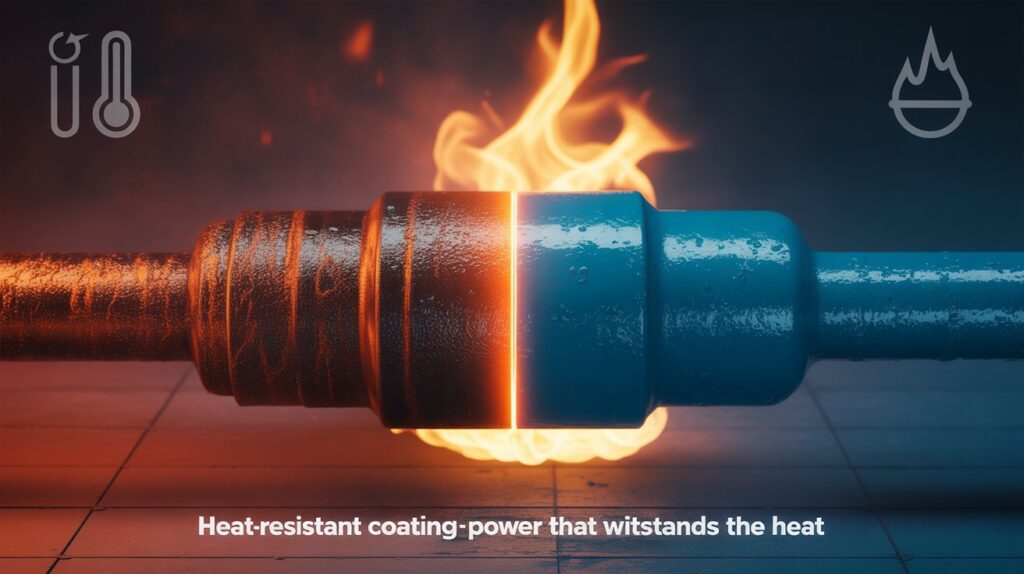Choosing the right heat-resistant coating for your project is critical to ensuring durability, safety, and maximum performance in demanding environments where high temperatures are a challenge. In 2025, with rapid technological advancements and stricter environmental regulations, your coating decisions matter more than ever. This comprehensive guide presents in-depth, trending content to help you confidently navigate the evolving world of heat-resistant coatings.
Why Heat Resistant Coatings Matter
Heat-resistant coatings protect valuable surfaces from damage, extend the lifespan of equipment, and improve energy efficiency by preventing heat loss or gain. These coatings perform in harsh conditions such as industrial furnaces, building exteriors, automotive parts, or solar-exposed rooftops, where regular paints would fail.
Market Trends for Heat Resistant Coatings in 2025
The global heat-resistant coatings market in 2025 is thriving, projected to reach $6.91 billion and achieving robust growth thanks to key trends:
- Rising demand in automotive, power generation, construction, and renewable energy sectors.
- Rapid expansion of eco-friendly, low-VOC, waterborne, and high-solid coating options to meet stricter emission regulations.
- Increasing use of smart coatings with self-healing and advanced thermal management properties.
- Surging demand for coatings with specialized properties tailored to electric vehicles, smart buildings, and defense equipment.
Understanding Types of Heat Resistant Coatings
Not all heat-resistant coatings are created equal. Here’s a breakdown of the most common types and their unique benefits:
| Coating Type | Max Temp | Primary Use | Pros | Cons |
| Silicone-based | 600°C | Automotive, machines, metals | Flexibility, weather resistance, heat resistance | Not the highest protection |
| Ceramic-based | 1200°C+ | Turbines, aerospace, furnace linings, exhausts | Extreme temp, chemical & thermal shock resistance | Costly, brittle |
| Epoxy | 150-200°C | Pipe linings, tanks, chemical industry | Corrosion & chemical resistance | Moderate temp applications |
| Fluoropolymer | 250–350°C | Cookware, industrial, non-stick applications | Chemical & weather resistance | Moderate heat resistance |
| Polyesters/Phenolics | 180-200°C | General industrial, electrical components | Cost-effectiveness | Lower temp, less durability |
| Powder coatings | Varies | Appliances, automotive, machinery | No VOCs, durability | Process-intensive |
Each coating’s effectiveness depends on raw materials, formulation technology, and end-user requirements.
Heat-Reflective & Cool Roof Coatings: Trending in 2025
With climate change concerns and energy costs rising, heat-reflective and cool roof coatings have become some of the most sought-after solutions:
- Solar reflective index (SRI) is a primary criterion—look for coatings with high SRI values to maximize solar reflectance and keep building interiors cool.
- Nanotechnology-based coatings deliver higher durability, better reflectivity, and improved sustainability.
- Top brands are introducing products that can reflect up to 97% of solar heat, leading to major energy and cost savings on air conditioning.
- These coatings apply to rooftops, building exteriors, chemical storage tanks, and even vehicle interiors in hot climates.
Key Considerations for Choosing a Heat Resistant Coating
Before you select the best coating, carefully assess these factors:
1. Maximum Operating Temperature
- Match the coating’s rated temperature to your project’s peak conditions.
- For surfaces exposed to over 600°C (exhausts, turbines), choose ceramic or advanced silicone formulas.
- For building and general industrial use, silicone, fluoropolymers, or high-reflective acrylics may be sufficient.
2. Substrate Material
- Metal substrates benefit most from ceramic and silicone-based coatings due to superior heat resistance and adhesion.
- Plastics require silicone-based or specialized polymeric coatings for flexibility and thermal stability.
3. Environmental & Chemical Resistance
- Consider potential exposure to chemicals, humidity, and UV rays. Some formulations are optimized for weatherability, others for chemical exposure.
- For corrosive environments, opt for coatings with chemical and abrasion resistance, such as epoxies or fluoropolymers.
4. Application Methods & Curing
- Choose a coating compatible with your available application method (spraying, dipping, brushing, powder coating).
- Some coatings require high-temperature curing, which can impact downtime. Evaluate whether air-dry or low-bake alternatives are suitable.
5. Durability & Reapplication Needs
- Check coating thickness, expected lifespan, and ease of maintenance.
- Some may offer self-healing, dirt-shedding, or other smart features to improve longevity and reduce maintenance.
6. Environmental Impact and Regulations
- Eco-friendly, low-VOC, or waterborne coatings are increasingly favored due to stringent global regulations and sustainability goals.
7. Cost vs. Performance
- Higher performance coatings may carry a steeper upfront price but save money long-term by reducing failures, downtime, or energy costs.
Comparing Different Types of Heat Resistant Coatings
| Feature | Ceramics | Silicones | Epoxy | Fluoropolymer | Powder Coatings |
| Max Temp Resistance | Extreme (>1200°C) | High (up to 600°C) | Moderate | Moderate | Varies by base |
| Chemical/Corrosion Resistance | High | Moderate | High | High | Varies |
| Mechanical Properties | Brittle | Flexible | Hard | Odorless, tough | Durable, hard |
| Cost | Highest | Moderate | Affordable | Higher | Moderate |
| Eco-friendliness | Good | Good | Moderate | Good | No VOC emissions |
Common Application Areas
- Industrial furnaces: Ceramic and metal-based coatings for extreme temperatures.
- Automotive parts/engines: Silicone and ceramic coatings for exhausts, manifolds, and other hot spots.
- Building exteriors/roofs: Acrylic, polyurethane, and nanotech-enhanced reflective coatings to reduce sunlight absorption and energy costs.
- Chemical tanks & pipelines: Epoxy, fluoropolymer, or phenolic coatings for corrosion, abrasion, and moderate heat resistance.
Step-by-Step Guide to Selecting the Right Solution
- Define your performance needs: Is your aim to conserve heat, manage overheating, reflect sunlight, or prevent chemical damage?
- Identify substrate and application environment: Assess what surface you’re coating and environmental conditions (humidity, chemicals, etc.).
- Determine operating temperature range: Choose a product with a proven track record above your maximum operating temperature.
- Consider regulatory/environmental needs: Ensure compliance with local emission rules—opt for low-VOC options if available.
- Check application methods: Select coatings designed to be applied using your available equipment and meeting timeline/downtime constraints.
- Consult technical data sheets: Get performance specs from manufacturers, including cure times, coverage rates, and expected lifetime.
- Request samples for testing: Before scaling up, test coatings in your real-world setting to verify performance and adhesion.
- Consult an expert or manufacturer: For specialized projects, work closely with a reputable coatings company to recommend the best customized solution.
Avoiding Common Selection Pitfalls
- Don’t choose solely on initial price—account for total life-cycle cost, including maintenance and reapplication.
- Avoid underestimating the importance of surface preparation; poor prep leads to adhesion failures.
- Don’t overlook environmental and operational factors—such as humidity, sunlight, and chemicals.
- Always check for compliance with relevant industry standards and certifications.
Innovative Trends to Watch in 2025
- Rise of self-healing and smart coatings in industrial and energy applications.
- Increasing use of nanoceramic and hybrid coatings, combining heat resistance with durability and flexibility.
- Expansion of AI-assisted coatings selection and predictive analytics for maintenance.
- Regulatory-driven shift towards solventless, low-emission coating systems.
Real-World Example Applications
- A steel manufacturer improved equipment efficiency and reduced maintenance by switching to a ceramic-based, high-emissivity coating for furnaces.
- An office complex in a hot urban area installed a high-SRI, nanotech reflective roof coating, reducing cooling costs by over 30%.
- An electric vehicle producer increased battery safety margins by applying specialized silicone-based coatings to battery modules for better heat management.
Sustainability & Environmental Considerations
- High-performance coatings can extend equipment life, reducing waste and replacement needs.
- Waterborne and low-VOC coatings safeguard the environment while delivering top heat protection.
- Some manufacturers now offer coatings made with recycled or renewable source inputs as part of sustainability initiatives.
Choosing a Trusted Partner
- Look for manufacturers with a track record in delivering industry-tailored solutions, innovation in eco-friendly coatings, and responsive technical support.
- Top global players include Akzo Nobel, BASF, Jotun, Sherwin-Williams, as well as regionally specialized suppliers focusing on unique environments.
Final Checklist for Your Project
- Have you defined your heat management goals clearly?
- Are all substrate and environmental conditions accounted for?
- Is your preferred coating compatible with your application methods and operational schedule?
- Have you checked the product’s full technical data sheet and verified certifications?
- Have you tested sample applications and checked with experienced professionals?
By systematically applying the information above, any industrial, commercial, or residential project owner or facility manager can make the best, trend-forward choice when selecting heat-resistant coatings in 2025 and beyond.

